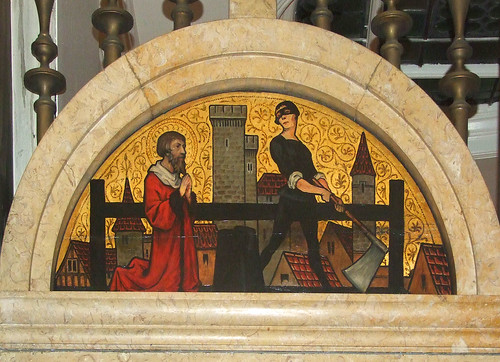| |
|
|
|
|
It comes as a surprise to some people to realise that St
Mary Moorfields is the only Catholic Church in the City
of London. St Etheldreda in Ely Place, which is often
thought of being a City church, is actually in the
Borough of Camden, and English Martyrs church near Tower
Hill station is in the Borough of Tower Hamlets. And the
dedication is an odd one, for Moorfields is some way to
the north of here. The reason is an interesting
historical accident. In the penal years of course there
must have been a number of secretive, illegal Catholic
chapels scattered throughout the City, and the Faithful
could also worship in the embassy chapels of Catholic
countries like Spain and Portugal. But in 1820, after
Catholicism began to be decriminalised in England, a
large Classical church was built at Finsbury Circus in
Moorfields to the north of the City and dedicated to the
Blessed Virgin. This St Mary
Moorfields was the biggest Catholic church in London in
its day, and from 1851 served as London's Catholic
pro-cathedral, the seat of Cardinal Wiseman. However,
plans were already well-advanced by then to build a
cathedral more suited to the triumphalism of the day, and
in 1884 the Catholic Church acquired a huge site off of
Victoria Street in west London. The construction of what
would be Westminster Cathedral commenced in 1895, and in
1899, when parts of the new building became useable for
worship, the site of St Mary Moorfields was sold off and
the church demolished.
The replacement church for the
Moorfields parishioners would be within the City, the
first new Catholic parish church to be built in the City
of London for more than 400 years. It would retain the
dedication of the former church. The architect was George
Sherrin, and the church opened for business on the Feast
of the Annunciation 1903. The site, roughly halfway
between Liverpool Street and Moorgate stations, was an
already established commercial one; Sherrin rebuilt the
entire row, squeezing a narrow entrance to the church
between two of the shops. Despite this it is a grand,
classical entrance, and if St Mary Moorfields doesn't
look much like a church from the outside then it is
perhaps a reminder of what was once the common setting of
many City churches, the frontage of their building
encroached on by shops and tenements. This only survives
elsewhere in the City today at St Peter Cornhill.
Large reliefs above the main
entrance depict four significant events in the story of
the Blessed Virgin: the Annunciation, the Nativity, the
Deposition and the Assumption. Above them stands a statue
of the Virgin and child being crowned by cherubs. You
step through and down into a long, almost windowless
church, the only daylight coming from rooflights in the
long domed ceiling. A 'north aisle' runs to the left (the
church is actually aligned to the north, so this aisle is
to the west). Arcades (blank on the right hand 'south'
side) and the ceiling lead the eye towards the vertical
columns of the apse, creating a sense of height and
depth. The gravitas is enhanced by a large crucifix,
nothing else - incidentally, the most recent revision of
Pevsner seems to have misread its notes here, describing
a spectacular altarpiece from the old church which I do
not think ever made its way into the new church, although
as Simon Bradley records there was a smaller version of
it here until 1964.
The wide becherubed font, however,
was brought here from the old church, and given a font
cover typical of the 17th Century City of London style,
but in many ways the new church was really a condensation
of the old. Despite the date of 1903, the interior of St
Mary Moorfields is really a design of eighty years
earlier, and that itself was a Georgian reimagining of
the Italian 15th Century. Because of this, the 20th
Century details do not merge as comfortably as might be
hoped, but are still good in themselves, including the
tympanum above the shrine to St Thomas More at the south
end of the aisle, which depicts his execution in 1920s
mosaic style. At the other end of the aisle, the altar is
surmounted by stained glass (though not, I think,
actually a window) depicting the Assumption, flanked by
St Thomas More and St John Fisher. This may have been
installed at the time of their canonisation by Pius XI in
1935, although it appears the work of a decade or so
earlier.
Simon Knott, December 2015
location: Eldon Street EC2M 7LS 3/064
status: working Catholic parish church
access: open seven days a week 6.45am - 6.45pm
website
 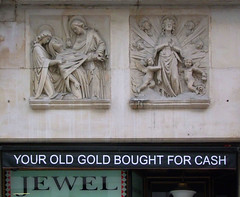  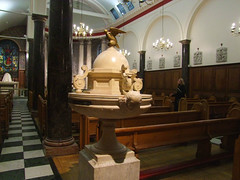 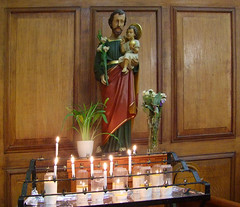  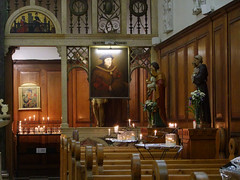 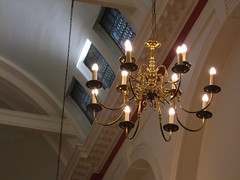
Commission
from Amazon.co.uk supports the running of this site
|
|
|
|
|
|


